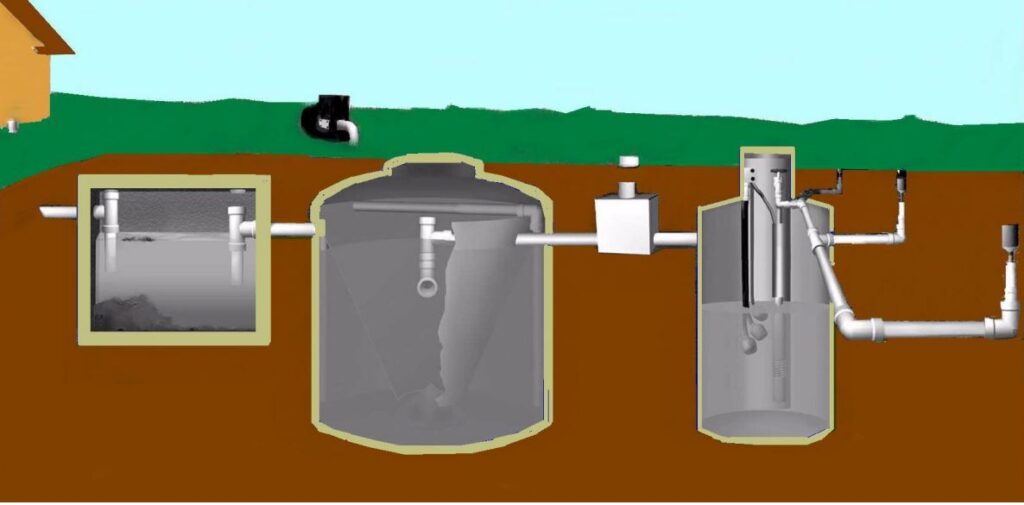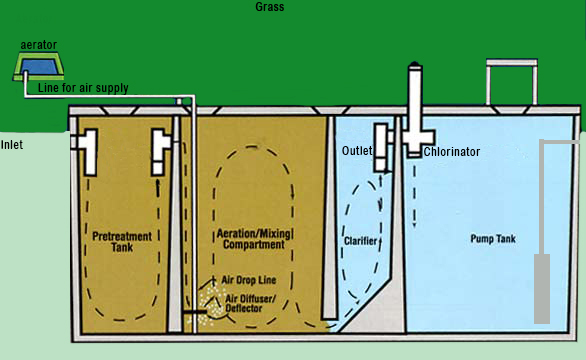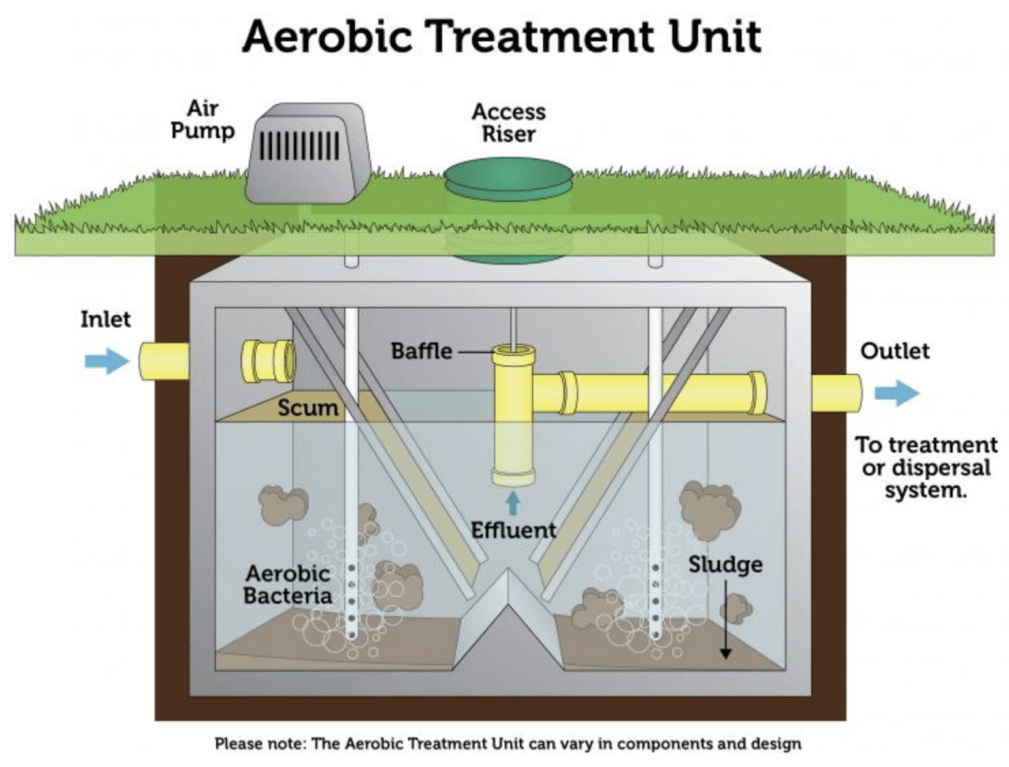In this article, you will learn all about aerobic septic systems and how they work. We will explain what an aerobic septic system is, its benefits, and how it differs from traditional septic systems. Additionally, we will cover the components and maintenance requirements of an aerobic septic system, as well as its potential drawbacks. By the end of this article, you will have a comprehensive understanding of aerobic septic systems and be able to make an informed decision about whether it is the right choice for your property.
Understanding Septic Systems
What is a septic system?
A septic system is an underground wastewater treatment system commonly used in rural areas or homes that are not connected to a municipal sewer system. It is designed to treat and dispose of household wastewater, including sewage and greywater, in a safe and environmentally friendly manner.
How does a septic system work?
A septic system works by relying on natural processes to treat the wastewater. It consists of a septic tank, where the wastewater initially flows, and a drainfield, where the treated water is dispersed into the soil. The bacteria in the septic tank break down the solids in the wastewater, while the drainfield allows for the natural filtration and absorption of the water into the surrounding soil.
Why are septic systems important?
Septic systems are important because they provide an effective solution for managing household wastewater in areas where a municipal sewer system is not available. They help protect the environment by treating wastewater on-site and preventing the contamination of local water sources. Additionally, septic systems help maintain public health by preventing the spread of diseases caused by untreated sewage.
Introduction to Aerobic Septic Systems
What is an aerobic septic system?
An aerobic septic system is a more advanced and efficient alternative to traditional septic systems. Unlike traditional systems that rely solely on anaerobic bacteria, aerobic septic systems use aerobic bacteria, which require oxygen to function. This additional oxygen allows for more efficient decomposition of waste and higher quality treatment of the wastewater.
How does an aerobic septic system differ from a traditional septic system?
The main difference between an aerobic septic system and a traditional septic system lies in the treatment process. In an aerobic system, the aerobic bacteria in the system require oxygen to break down organic matter and convert it into harmless byproducts. This process produces cleaner and clearer water compared to the anaerobic process in traditional systems.
Additionally, aerobic systems often include additional components such as aerators, clarifiers, and disinfection units to enhance the treatment process and improve the quality of the treated water. These components make aerobic septic systems more efficient and effective in treating wastewater.

Components of an Aerobic Septic System
Aerobic septic tank
One of the key components of an aerobic septic system is the aerobic septic tank. This tank is similar to a traditional septic tank but is designed to introduce oxygen into the wastewater. It typically has three chambers: a settling chamber, an aeration chamber, and a final settling chamber. The settling chambers allow solids to separate from the wastewater, while the aeration chamber introduces oxygen to encourage the growth of aerobic bacteria.
Aerator
The aerator is a mechanical device that supplies oxygen to the aerobic septic tank. It typically consists of a pump and diffuser, which inject air into the wastewater. The aerator ensures a constant supply of oxygen to the aerobic bacteria, allowing them to thrive and effectively break down the waste.
Clarifier
The clarifier is responsible for separating the solids from the treated water. It is typically located after the aerobic septic tank and allows any remaining solids to settle to the bottom of the tank. The clarified water is then directed to the disinfection unit for further treatment.
Disinfection unit
The disinfection unit is an optional component in an aerobic septic system. It is used to further treat the clarified water and remove any remaining pathogens or bacteria. Common disinfection methods include ultraviolet (UV) light treatment or chlorination. The treated water is then safe to be released into the environment or reused for irrigation purposes.
Functioning of an Aerobic Septic System
Wastewater treatment process in aerobic systems
In aerobic septic systems, the wastewater treatment process begins in the aerobic septic tank. As the wastewater enters the tank, the first settling chamber allows the solids to settle at the bottom. The liquid then flows into the aeration chamber, where the aerobic bacteria thrive in the presence of oxygen. These bacteria break down organic matter through the process of aerobic digestion. The final settling chamber allows any remaining solids to settle before the water moves to the next stage of treatment.
Role of the aerobic septic tank
The aerobic septic tank is a crucial component in an aerobic septic system. It provides the necessary environment for aerobic bacteria to flourish, promoting the efficient decomposition of organic matter. The tank’s design allows for the separation of solids and the retention of wastewater for sufficient contact time with the bacteria.
Working of the aerator
The aerator plays a vital role in an aerobic septic system by supplying oxygen to the septic tank. The pump in the aerator draws air and injects it into the wastewater through the diffuser. This continuous supply of oxygen creates the perfect conditions for the aerobic bacteria to multiply and decompose the waste more efficiently compared to traditional septic systems.
Importance of the clarifier
The clarifier is an important component in an aerobic septic system as it ensures the separation of solids from the treated water. It allows any remaining solids to settle to the bottom of the tank, reducing the amount of suspended solids in the effluent. This process helps prevent clogging of the drainfield and ensures the overall effectiveness of the system.
Disinfection unit and its purpose
The disinfection unit, if installed, further enhances the treatment process in an aerobic septic system. It eliminates any remaining pathogens or bacteria in the treated water, making it safe for release into the environment or reuse for irrigation purposes. Ultraviolet (UV) light treatment or chlorination are commonly used methods to disinfect the water, ensuring it meets the necessary quality standards.

Benefits of Aerobic Septic Systems
Improved wastewater treatment
Aerobic septic systems offer improved wastewater treatment compared to traditional septic systems. The additional oxygen provided by the aerator allows for more efficient decomposition of organic matter, resulting in cleaner and clearer water. This higher quality treated water is less likely to cause issues with clogging or contamination in the drainfield, ensuring optimal performance of the system.
Reduced environmental impact
Aerobic septic systems have a reduced environmental impact compared to traditional septic systems. The advanced treatment processes in aerobic systems result in a higher level of wastewater treatment, reducing the risk of water pollution and contamination of local water sources. This helps protect the environment and maintains the overall ecological balance.
Lower maintenance requirements
Aerobic septic systems generally have lower maintenance requirements compared to traditional septic systems. The aerobic digestion process in these systems reduces the accumulation of solids, minimizing the need for frequent pumping. Additionally, the inclusion of components like aerators and clarifiers aids in the efficient treatment of wastewater, reducing the risk of system failures and costly repairs.
Compatibility with various soil types
Aerobic septic systems are compatible with various soil types, making them suitable for a wider range of properties. Unlike traditional septic systems, which may struggle with clay or compacted soils, aerobic systems can effectively treat wastewater in these challenging soil conditions. This flexibility allows homeowners to enjoy the benefits of aerobic septic systems, regardless of their soil type.
Installation and Maintenance
Professional installation
It is important to have an aerobic septic system professionally installed to ensure proper functioning and compliance with local regulations. Professional installers have the necessary expertise and experience to determine the ideal system size, location, and components based on your property’s specific needs and local requirements.
Regulations and permits
Before installing an aerobic septic system, it is essential to familiarize yourself with local regulations and obtain any necessary permits. Different regions may have specific requirements for septic system installations, so it is crucial to comply with these regulations to avoid penalties or violations.
Regular maintenance and inspection
Regular maintenance and inspection are vital for the proper functioning of an aerobic septic system. This includes periodic inspections of the components, such as the aerator, clarifier, and disinfection unit, to ensure they are working effectively. It is also important to have the tank pumped regularly to remove accumulated solids and prevent backups or system failures.
Troubleshooting common issues
In the event of system issues or malfunctions, it is advisable to contact a professional septic system service provider. They can troubleshoot and diagnose any problems, such as clogs, leaks, or component failures, and provide the necessary repairs or replacements. Prompt attention to system issues can help prevent further damage and ensure the continued functionality of the aerobic septic system.

Cost Considerations
Initial installation cost
The initial installation cost of an aerobic septic system can vary depending on factors such as the size of the property, the number of occupants, and the specific system requirements. However, in general, aerobic systems tend to have a higher upfront cost compared to traditional septic systems due to the additional components and technology involved.
Long-term operating expenses
While the initial installation cost may be higher, aerobic septic systems can offer long-term cost savings. The improved treatment process in these systems reduces the frequency of pump-outs and maintenance requirements, resulting in lower ongoing operating expenses. Additionally, the higher quality treated water may also lead to reduced landscaping and irrigation costs as it can be reused on-site.
Comparison with traditional septic systems
When considering the cost of an aerobic septic system, it is important to compare it with traditional septic systems. While the upfront cost of an aerobic system may be higher, the improved treatment efficiency and lower maintenance requirements can offset these costs over time. Additionally, the environmental and health benefits of aerobic systems should also be taken into account when comparing the overall value and cost-effectiveness.
Potential Limitations and Risks
Power requirements
Aerobic septic systems require a constant power supply to operate effectively. This power is needed to run the aerator, which supplies oxygen to the septic tank. In the event of a power outage, the aerobic bacteria may not receive sufficient oxygen, resulting in a decrease in system performance. It is important to have a backup power source, such as a generator, to ensure continuous operation during power outages.
Odor control
Aerobic septic systems, like traditional systems, may produce odors if not properly maintained or if there is a component failure. Regular maintenance, including routine pumping and inspection, can help prevent odors from becoming an issue. If persistent odors occur, it is advisable to contact a professional septic system service provider to identify and address the underlying cause.
Risk of system failure
As with any septic system, there is a risk of system failure in aerobic septic systems if not properly maintained or due to component malfunctions. Regular inspections and maintenance, including pumping and component checks, are essential to prevent system failures. Prompt attention to any issues or malfunctions can help avoid costly repairs or replacements.
Proper system management
Aerobic septic systems require proper management to ensure their continued functionality. This includes following recommended practices such as avoiding the disposal of non-biodegradable items, reducing water usage, and regularly inspecting and maintaining the components. By adhering to proper system management practices, homeowners can ensure the longevity and effectiveness of their aerobic septic system.

Aerobic Septic Systems and Property Value
Impact on property appraisal
The presence of an aerobic septic system can have a positive impact on the property value. Potential buyers often see aerobic systems as a more advanced and efficient solution compared to traditional septic systems. The improved treatment efficiency and reduced environmental impact of aerobic systems can be viewed as desirable features, making the property more attractive to buyers.
Selling points for potential buyers
When selling a property with an aerobic septic system, it is important to highlight its benefits and advantages. This can include its improved wastewater treatment capabilities, reduced maintenance requirements, and compatibility with various soil types. Including relevant documentation, such as maintenance records and system warranties, can also reassure potential buyers about the system’s reliability and functionality.
Maintenance records and system documentation
Maintaining accurate records of the aerobic septic system’s maintenance and inspections is important for both property owners and potential buyers. These records can provide evidence of proper system management and can be used to address any concerns or issues that may arise. Keeping documentation organized and readily available can help facilitate the sale of a property and ensure transparency in the transaction.
Conclusion
In conclusion, an aerobic septic system offers a more advanced and efficient solution for wastewater treatment compared to traditional septic systems. The additional oxygen provided in these systems enhances the decomposition process, resulting in improved treatment quality and reduced environmental impact. While they may require a higher upfront cost and regular maintenance, the long-term benefits of aerobic septic systems, such as reduced maintenance requirements and compatibility with various soil types, make them a worthwhile investment. Proper professional installation and ongoing maintenance are crucial to maximizing the performance and lifespan of an aerobic septic system. By understanding the components, functioning, benefits, and considerations associated with aerobic septic systems, homeowners can make informed decisions and ensure the continued functionality and efficiency of their wastewater treatment system.

